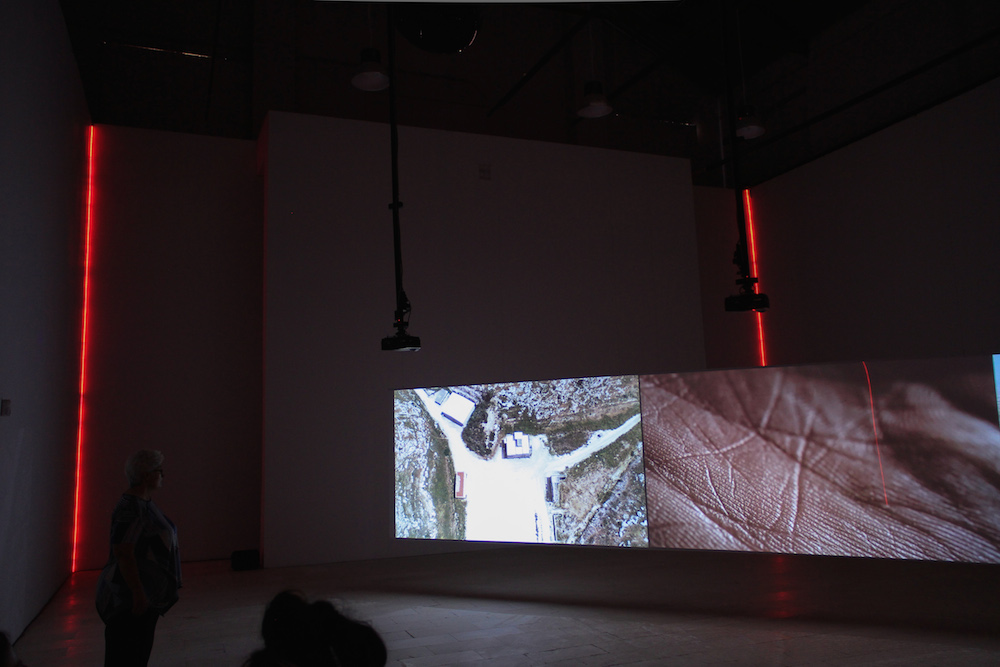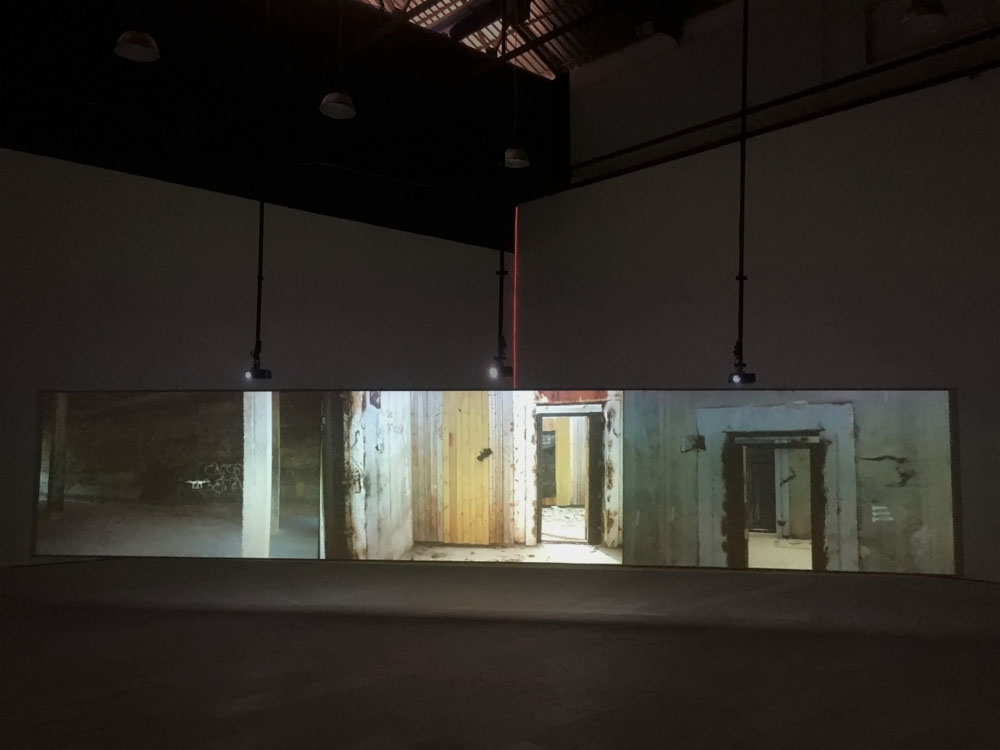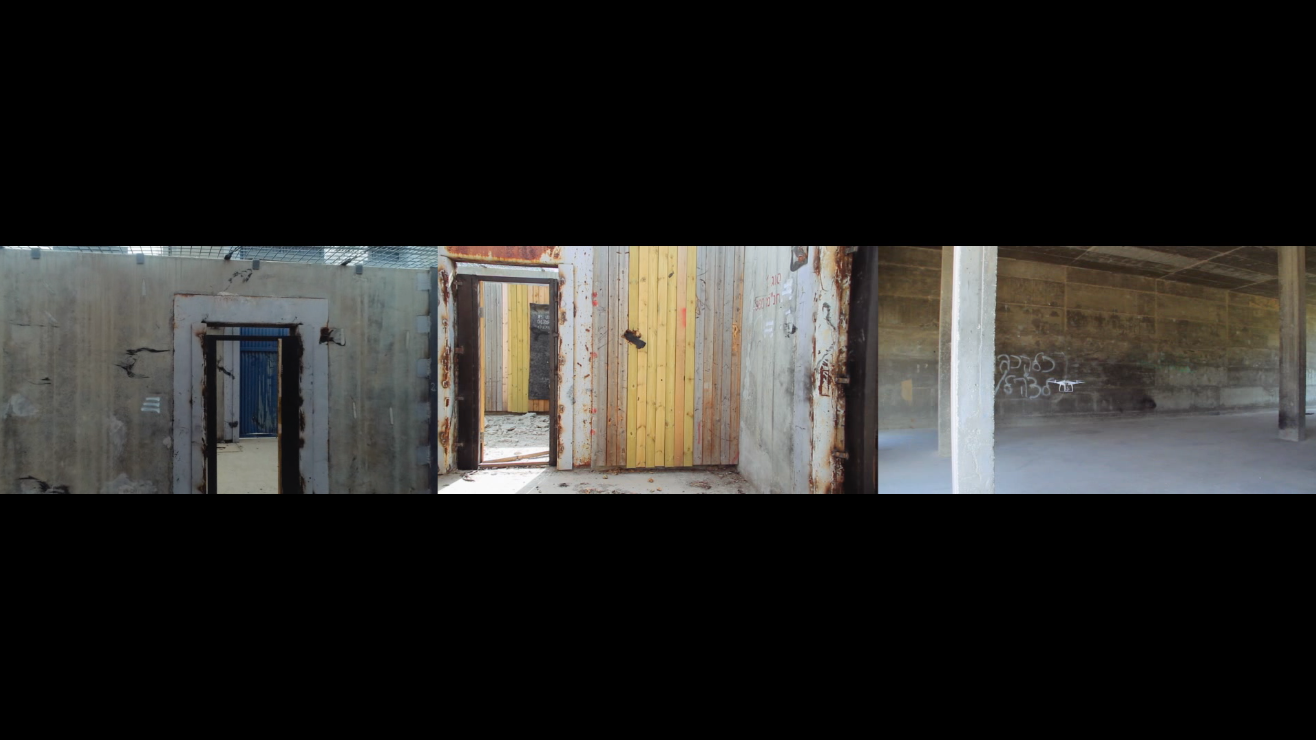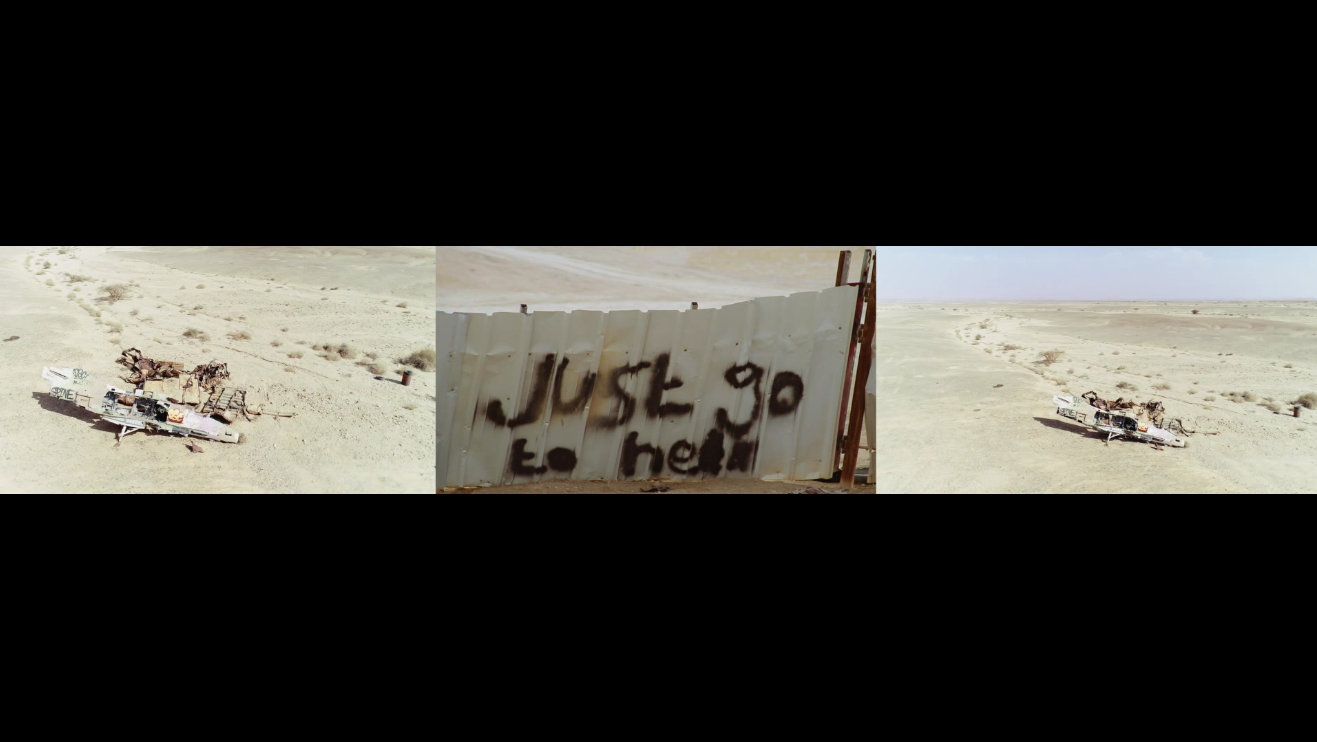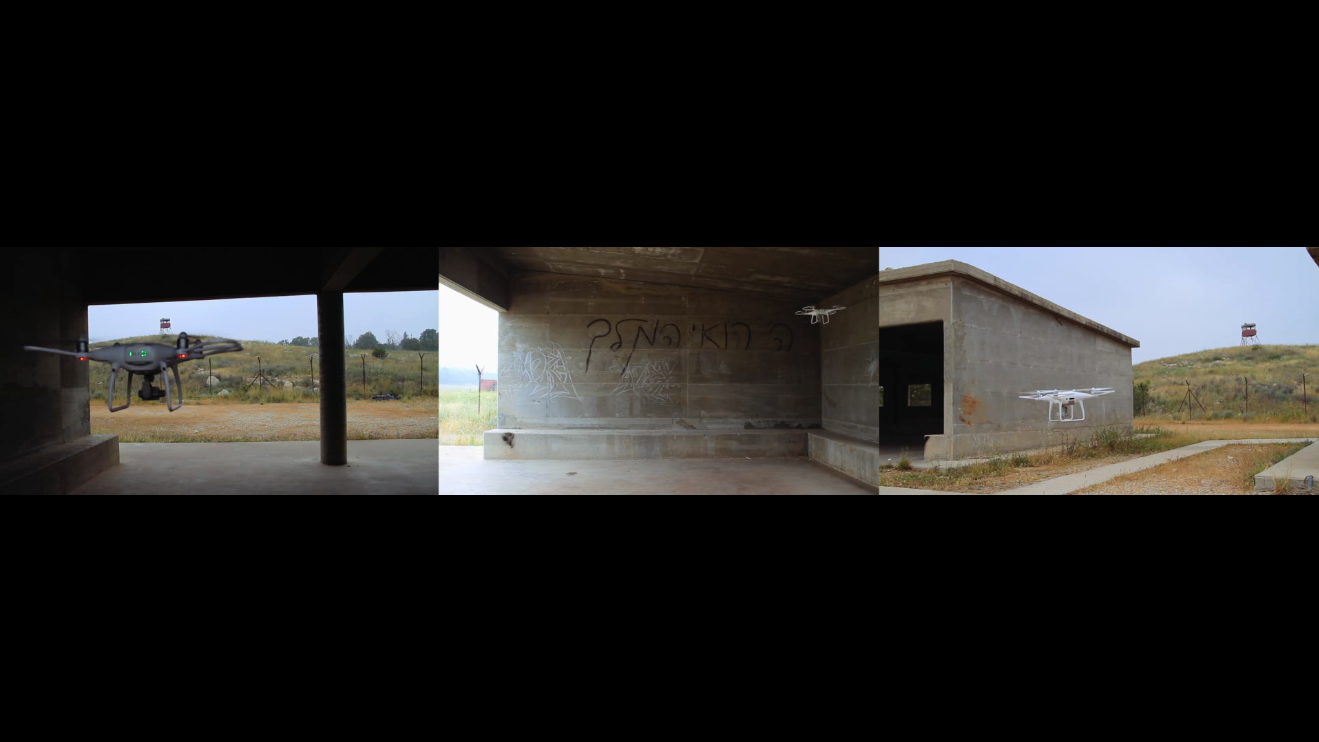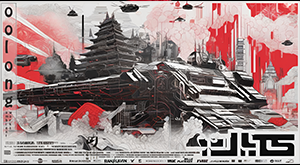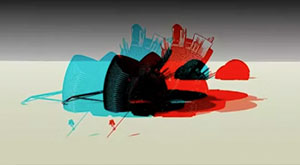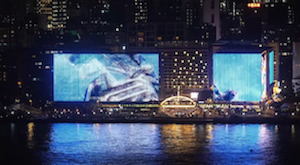Battlefields is a three channel (2018 13:05 min) 9×2 meter video & sound & sound to light installation that explores fragile human physical intimacy and vast landscape war scars and reminiscence via drone technology and photography.
Ran Slavin – Battlefields, 2018
Excerpt:
The ethics and aesthetics of drones are central in Ran Slavin’s research field. Drones today are more relevant than ever. In the modern arms industry, in surveillance practices, but also in the modern consumer society, in the entertainment industry, in amateur photography. For many of us, drones are yet another exciting development of technology that allows remote-controlled cameras to capture the world from above. In their simplest forms, drones are now on the shelves of toy stores and are a popular choice as Christmas presents.
Yet, today drones are killing. And, indeed, they do so from a distance and with unprece-dented surgical precision. First and foremost, drones are unmanned war machines, whose operators are hundreds of miles away, monitoring in front of a computer screen the killing process, as if they are playing a popular war video game.
And if the squadrons of drones do not reap victims, there is no doubt they surveille. They collect information about everything: about enemy posts, shooting ranges, fire zones, combat zones, refugee camps, terrorist camps, nuclear and non-nuclear plants, military logistics services, hospitals, fuel tanks, the road network – whatever the mind of man can conceive and even more. As the artist says: “Drones are an eye in the sky. A body extension. A prolonged vision tool. A bio extension in a way. A ghost of sorts. A tool that allows you to see and remain unseen.”
These invisible death and surveillance flying squadrons are now the spearhead of every army. According to data published by the “New America” think tank: “So far, nine countries have used armed drones in combat: the United States, Israel, the United Kingdom, Pakistan, Iraq, Nigeria, Iran, Turkey, and Azerbaijan. But many other countries are arming drones. In the New America’s World of Drones database, countries are sorted into three groups: those that use drones in combat, those that possess armed drones but have not used them in combat, and those who are developing armored drones. A country’s drone capabilities are classified according to the U.S. Air Force tier system. Tier I includes low altitude, low endurance drones like the Orbiter; Tier II is composed of medium altitude, long endurance drones like the Reaper or the Predator; and Tier II+ applies to high altitude, long endurance drones like Global Hawk.”
Furthermore, according to the same data, about twenty countries around the world are producing drones that they export to more than seventy countries. The three major producers and suppliers of armed drones are the United States, Israel and China. One of the most popular drones is the MQ-9 Reaper. It is an armed, multi-mission, medium-altitude, long-distance remote piloted aircraft (RPA) that is primarily used in a hunter/killer role against dynamic execution targets and secondarily as an intelligence collection asset. Apart from the US military, the MQ-9 Reaper is used by Australia, the Dominican Republic, Germany, France, Great Britain, Italy, India, Spain, the Netherlands and Belgium. In fact, the squadron patch of the MQ-9 Reaper operators depicts death with red eyes and a long blood-dripping scythe. The motto reads: “That Others May Die”.
Israel is the world’s largest drone exporter. IAI Heron (Machatz-1) is designed to compete with the MQ-9 Reaper. According to the Arms Export Database of the Stockholm International Peace Research Institute (SIPRI), 41% of all drones that were exported between 2001 and 2011 came from Israel. Israel has been using UAV’s (unmanned aerial vehicles) for decades, like in Yom Kippur War with Egypt in 1973, and the First Lebanon War in 1982. Extensive use of drones also takes place in the Gaza Strip. The Israeli unmanned aerial vehicles have hit many Hamas related targets, including senior military commander Ahmed Jabari, who was killed on November 14, 2012.
In Battlefields, Ran Slavin is studying the aesthetics of drone surveillance and depicts the geological scars and war remnants of five deserted military locations in Israel –army strongholds, fire zones, shooting ranges and urban warfare training facilities– and juxtaposes them with both the personal and the political scars that are engraved and marked on the private, human body.
In this three-screen video, the artist, always using the eerie gaze of drones, wanders in the ruins of war exercises, performing a sort of aerial forensic archeology, where the “posthumous” effect of human warlike insanity is clearly marked. The deserted fire zones, the lunar landscape of the post-destruction reality, engraved as if by continuous waves of cosmic winds, contrasts (tragically and visually) with the poetics of the human body.
Of a female body that clearly alludes to Gustave Courbet’s masterpiece of L’Origine du Monde/The Origin of the World (1866). A female body which despite the fact that it conveys Courbet’s “origin of the world” has been subjected over time to social, cultural and political exploitation and abuse. Thus, the macroscopic wanderings in the folds of the skin of the breathing female body are one and the same with the scratches, the scars and the bombed geological formations of the surface of the earth’s crust.
This poetic elegy by Ran Slavin is at the same time a war elegy, a love elegy but also an elegy of sorrow. The red rays that traverse the space, responding to the call of the mesmerizing sounds of the musical background, unfortunately confirm what Walter Benjamin says at the end of The Work of Art in the Age of Mechanical Reproduction, that mankind “[…] can experience its own destruction as an aesthetic pleasure
of the first order.”
Battlefields, 2018, three-screen video, sound, sound to light, 9 x 2 m
Concept, direction, editing: Ran Slavin / Drone operator: Ariel Zukerman / Second camera: Ran Slavin / Dolly cam operator: Maayan Blech / Location manager: Oren Yad Shalom / Light programming: Amir Bolzman, Gideon Levi / Body model: Imre Van Opstal / Music: Avishai Cohen / Thanks to Dr. Yiannis Toumazis, NIMAC, Nicosia, Cyprus, and to Hasselblad Foundation, Gothenburg, Sweden
The Drone Vision: Warfare, Surveillance and Protest project is a collaborative initiative between Valand Academy, Gothenburg University and the Hasselblad Centre.
Led by Dr. Sarah Tuck, the project examines how drone technologies alter the material assemblages through which warfare, surveillance and protest take place.
Text by Dr Yiannis Toumazis
